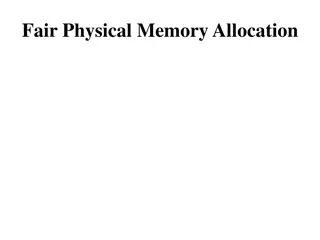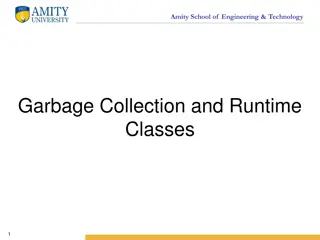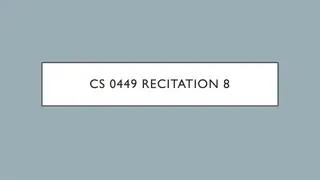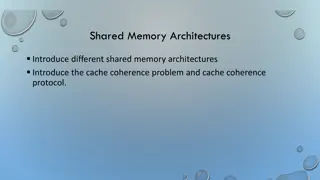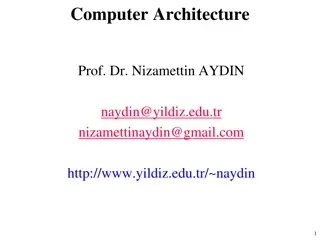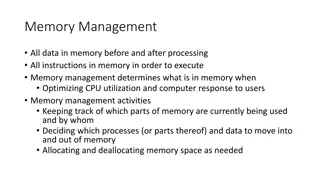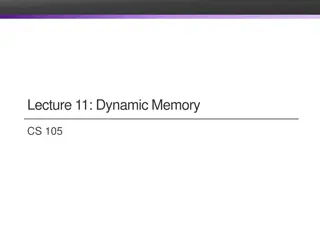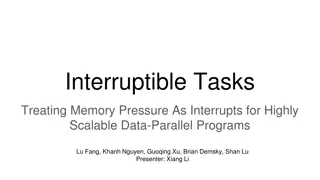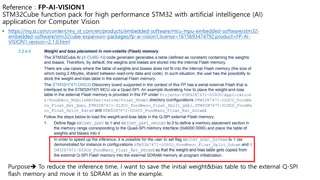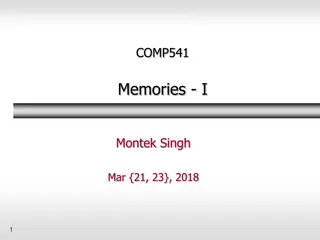
Understanding Magnetic Disk Technology in Computer Architecture
Learn about magnetic disk storage technology in computer architecture including types, components, and operation. Explore the organization, formatting, and layout of magnetic disks for efficient data storage and retrieval.
Download Presentation

Please find below an Image/Link to download the presentation.
The content on the website is provided AS IS for your information and personal use only. It may not be sold, licensed, or shared on other websites without obtaining consent from the author. Download presentation by click this link. If you encounter any issues during the download, it is possible that the publisher has removed the file from their server.
E N D
Presentation Transcript
ARSITEKTUR KOMPUTER PERTEMUAN 6
Recall: Chapter 4 Common Memory Parameters Memory Type Technology Size Access Time Cache Semiconductor RAM Semiconductor RAM 128-512 KB 4-128 MB 50 ns 10 ns Main Memory Magnetic Disk Optical Disk Hard Disk Gigabyte 10 ms,10 MB/sec CD-ROM Gigabyte 300 ms, 600 KB/sec Magnetic Tape Tape 100s MB Sec-min.,10MB/min
Types of External Memory Magnetic Disk Optical Magnetic Tape
Magnetic Disk Disk A circular platter constructed of nonmagnetic material called substrate Aluminium (old) Glass (new) Coated with a magnetisable material
Magnetic Disk (Cont.) Glass Improved surface uniformity Increases reliability Reduction in surface defects Reduced read/write errors Better stiffness to reduce disk dynamics Greater ability to withstand shock and damage
Magnetic Disk Read/Write Mechanisms Recording & retrieval via conductive coil called a head May be single read/write head or separate ones During read/write, head is stationary, platter rotates
Magnetic Disk Read/Write (Cont.) Write Read Traditional Magnetic field moving relative to coil produces current Coil is the same for read and write Contemporary Separate read head, close to write head Partially shielded magneto resistive (MR) sensor Electrical resistance depends on direction of magnetic field High frequency operation Higher storage density and speed Current through coil produces magnetic field Pulses sent to head Magnetic pattern recorded on surface below
Magnetic Disk Organization, Formatting & Layout Term Description Head A small device capable of reading from or writing to a portion of the platter rotating beneath it Track Organize data on the platter in a concentric set of rings Width Track width = head width Gaps separate the adjacent tracks Sectors Form of transferring the data Fixed length or variable length
Magnetic Disk - Velocity Issue: Bit near centre of rotating disk passes fixed point slower than bit on outside of disk Solution: Increasing the spacing between bits of information recorded in segments of the disk The info can then be scanned at the same rate by rotating the disk at a fixed speed known as constant angular velocity (CAV)
Magnetic Disk - Layout Methods Diagram
Magnetic Disk Constant Angular Velocity The disk is divided into a number of pie-shaped sectors and into a series of concentric tracks Advantage of CAV: The individual blocks of data can be directly addressed by tracks and sectors Disadvantage of CAV: The amount of data that can be stored on the long outer tracks is the only same as what can be stored on the short inner tracks
Magnetic Disk Multiple Zone Recording The surface is divided into a number of concentric zones The number of bits per track is constant (Within the zone) Zones farther from the center contain more bits (since more sectors) than zones closer to the center Advantage: Increase density Disadvantage: Require complex circuitry
Magnetic Disk Physical Characteristics Head motion Fixed head One read write head per track Heads mounted on fixed ridged arm Movable head One read write head per side Mounted on a movable arm
Magnetic Disk Physical Characteristics (Cont.) Removable disk Can be removed from drive and replaced with another disk Provides unlimited storage capacity Easy data transfer between systems Non-removable disk Permanently mounted in the drive
Magnetic Disk Physical Characteristics (Cont.) Multiple Platter One head per side Heads are joined and aligned Aligned tracks on each platter form cylinders Data is striped by cylinder Reduces head movement Increases speed (transfer rate)
Magnetic Disk Physical Characteristics (Cont.) Tracks and Cylinders
Magnetic Disk Classifications Head mechanism #1 Traditional head Positioned a fixed distance above the platter-allowing an air gap #2 head mechanism that actually comes into physical contact with the medium during R/W operation Used in floppy disk 8 , 5.25 , 3.5 Small capacity Up to 1.44Mbyte (2.88M never popular) Slow Universal Cheap
Magnetic Disk Classifications (Cont.) Head mechanism #3 Winchester Aerodynamic gap Generate or sense an electromagnetic field of sufficient magnitude - write/read Used in sealed drive free of contamination able to reduce the risk of error Operate closer to the disk s surface greater data density Material - Aerodynamic foil - rests lightly on the platter s surface
Magnetic Disk - Performance Depends on; Computer system OS Nature of the I/O channel Disk controller hardware
Magnetic Disk Performance (Cont.) General timing of disk I/O transfer Seek time Moving head to correct track (Rotational) latency/delay Waiting for data to rotate under head Access time = Seek + Latency Transfer rate-the time required for the transfer data

